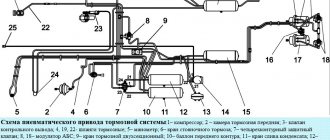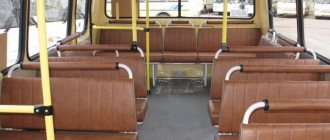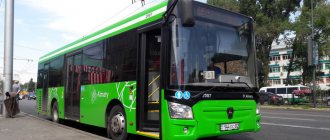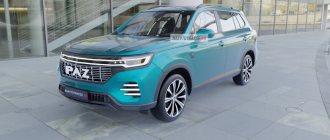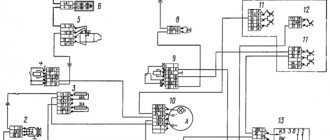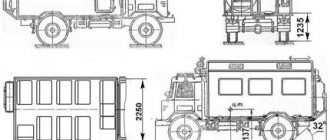The electrical equipment system of the bus is single-wire; the negative terminals of the current sources are connected to the body (“ground”) of the bus. Rated voltage 12V.
The power sources on the bus include a battery and an alternator with a built-in rectifier.
The generator is connected in parallel with the battery.
The installation provides power to consumers in any engine operating mode, as well as recharging batteries.
The electrical relay unit is located on the panel under the casing above the driver's door (Fig. 1).
The generator excitation circuit unloading relay 90.3747 is located in the engine compartment near the generator.
The battery (abbreviated as battery) 6ST 100 with a voltage of 12V and a capacity of 100 Ah is installed in the battery box located on the right side of the body behind the passenger door.
It is allowed to use imported batteries with similar characteristics.
There are two battery switches in the battery box: one pos. 8 (Fig. 2) - disconnecting the “battery”, with remote control from the button on the instrument panel; the other - pos. 1 — shutdown “- battery” with mechanical shutdown.
When you turn off the “+ battery” button on the instrument panel, the alarm system, emergency switch power supply, door mechanism control, and liquid heater are not turned off.
To completely disconnect the battery, you need to turn the handle of the mechanical switch 1.
Attention! When parking the bus for a long time, it is necessary to turn off the “- battery” with a mechanical switch.
Attention! When turning off the “+ battery” button located on the instrument panel, it is prohibited to hold the button pressed for more than 2 seconds.
In an emergency, the battery can also be switched off using the emergency switch. The emergency switch can have three key positions:
Power fuse block
The power fuse block is made in the form of high-power fuse links BPR-5-4, located in the battery box on the right side. May include additional conventional fuses on the left side of the block.
General scheme
Description
- 90A Generator
- 40A Side lights
- 60A Fuse box, headlights, ignition
- 60A Fuse Box
- 20A ABS
- 25A Heater
- 10A Emergency mode
- 10A Battery box socket
Is it possible to install LEDs in taillights?
According to all norms and laws, it is forbidden to install such bulbs in taillights. LEDs are prohibited from being installed if the manufacturer has not included the possibility of their use in the vehicle design. The same requirements apply to high and low beam headlights if the brand of lamps does not correspond to the recommended factory markings.
In this review, we will consider the following car rear headlights:
- Side lights with installed LED lamps.
- Fog lamp.
- Brake signal.
- License plate light.
Taking into account the regulations on the admission of cars to road traffic, lamps, headlights and other optics can be divided into the following types:
- With xenon lamps.
- With incandescent light bulbs.
- Fog lights.
The compliance of the type of lamps with light optics is established in the requirements of the Technical Regulations. For 2022, this document includes the following types of incandescent light bulbs:
- DC, DR, DCR – xenon sources.
- HC, HR, HCR – halogen lamps.
- F3, B – anti-fog.
Having familiarized yourself with the Technical Regulations, you can understand that the marking refers to 4 types of headlights and lanterns. But the regulations say nothing about LED elements. What is the reason? The answer is simple: LED lamps are not approved by regulations, since they are not intended for installation in the structure of cars and other vehicles. They cannot be used because they do not match the type of flashlights.
Factory specialists often plan to install LED lamps on the assembly line only for businessmen’s cars. In this case, the brightness of the light bulbs is not important. The main importance is that the type of lantern or headlight matches the type of lamp.
The structure of the electrical equipment of the PAZ 3205 bus
The electrical system includes the following modules:
- External lighting devices
- Sound and light alarm modules.
- Interior lighting of the cabin and driver's workplace.
- Glass cleaning equipment.
- Standard system of control and measuring instruments.
- Equipment for providing interior microclimate.
- Passenger door control system.
These technical modules are powered by a standard battery with a voltage of 12 Volts. Some of the above modules have converters that reduce the current to 8A. The remaining modules are powered from a DC network with a power of 16A.
INTERIOR
Space is one of the strong points of this SUV. The space is further emphasized by the burnt sugar leather seats (on the Premium trim). A considerable number of details in the interior are made by hand, which adds special charm and comfort.
By the hands of masters
What is done by hand is done with all the heart and attention to detail. Cadillac Escalade designers are convinced of this personally
Automatic seat heating
It’s raining or frosty outside, but inside it’s warm, like home. The seats in the first two rows of the Escalade are equipped with automatic heating and ventilation. So any bad weather outside the cabin turns into a calming landscape.
Third row with electric drive
If you need to quickly free up additional trunk space, the driver can do it at the touch of a switch. Both rear rows of seats fold down into a flat, protective surface. Removing just one rear row gives you a boot capacity of 2,172 liters, while folding the passenger area behind the first row completely expands to 3,424 liters - plenty of space for moving or camping, right?
INSTRUCTIONS FOR REPAIR AND OPERATION OF SPECIAL TRUCKS.
Sometimes it becomes necessary to turn the headlight in a vertical plane perpendicular to the direction of movement, since the reflected line delimiting the light and dark zones converges with the reference line on the screen at an angle. Wiring diagram for turn signals and hazard warning lights 1 - instrument switch and starter lock; 2 - block
Some of the lamps in one row of shades are connected using a two-wire circuit. After this, by changing the value of the load resistance, reduce the voltage at the generator terminals to the nominal value. This reduces the imbalance of the bridge R1, R2, R4, R5.
Circuits for switching on the generator excitation winding: a - self-excited generator. For safety reasons, headlights may only operate after careful adjustment. Moreover, they are all assembled into two blocks located near the steering wheel. It is prohibited to operate windshield wipers on dry glass, as this can cause, on the one hand, overheating of the engines, and on the other, scratches on the glass.
The operation of the direction indicators and hazard warning lights is monitored by indicator lamps.
The voltage regulation of an alternating current generator, like that of a direct current generator, is carried out by regulating the excitation current. If the value of the short circuit current differs significantly from the manufacturer's data, the starter may have malfunctions, which were described above. How to Read a Car Wiring Diagram
See also: Safety rules for measuring insulation resistance
About classic UAZ SUVs and off-road vehicles
When the measurement voltage is 24 V, the test lamp should light up, since transistor G4 is open to full excitation. Maintenance during inspection: - check the power of the installed lamps; lamps must be installed with such power that the turn relay operates; — check the turn-on time of the turn relay with lamps of rated power, this time should not exceed 1 s.
When you press button 13, the electromagnet 15 of the electropneumatic valve is de-energized, the valve opens, and compressed air acts through the pneumatic cylinder on the engine stop lever. The reference curve is the voltage pulse curve when connecting a full-wave rectifier, which is shown in Fig.
From a diagnostic point of view, the main factor for a capacitance is the magnitude of the discharge current.
As capacitor C1 charges, its current decreases to such a value that it is insufficient to keep transistor T1 open. Addition to the operating and repair manual for MAZ vehicles The manual is an addition to the operating manual for MAZ vehicles and contains the main technical characteristics, information on the design, adjustments and maintenance of original components and assemblies of dump trucks and MAZ-XX chassis. Information on the design, adjustments and maintenance of components and assemblies borrowed from MAZ family vehicles is presented in the main operating manual. But it will stop working if you turn off the power using switch 1 lock.
see also
The RSA interrupter relay contains: an electronic master device - a current pulse generator; executive electromagnetic relay P1; paired relay P2 for monitoring the inclusion and serviceability of the direction indicators and an electronic protection circuit. A bridge consisting of resistors R1, R2 and R4, R5 receives additional unbalance. The fog lights are turned on by switch 4 through control relay K1 of block 5.
In Fig. The remaining modules are powered from a DC network with a power of 16A. For measurements, you need an accurate voltmeter designed to measure low voltages. When the measurement voltage is 24 V, the test lamp should light up, since transistor G4 is open to full excitation. The brake light 6 is turned on by relay K4 of block 1.
The structure of the electrical equipment of the PAZ 3205 bus
Their number increases over time, and their capacity decreases. The center of the illuminated area on the screen, the brightest spot, should not deviate away from the vertical crossbar of the cross-shaped mark. Addition to the operating and repair manual for MAZ vehicles The manual is an addition to the operating manual for MAZ vehicles and contains the main technical characteristics, information on the design, adjustments and maintenance of original components and assemblies of dump trucks and MAZ-XX chassis.
Promotional offers based on your interests: Battery, its monitoring and diagnostics Check by determining the density of the electrolyte. Naturally, changing the direction of the discharge current causes the chemical reaction to flow in the opposite direction, as shown in Fig. The remaining modules are powered from a DC network with a power of 16A. In the normal mode of the turn signal, this is performed by a combination switch. Overview of the electrical circuit of the 1k62 lathe
Relay blocks
Block in the engine compartment
This panel is covered with a protective cover. It can also be located on the panel under the casing above the driver's door.
Scheme
Decoding
- turn and hazard warning relay
- rear fog light relay
- low beam headlight relay
- headlight high beam relay
- brake signal relay
- alarm relay
- horn relay
- fog light relay
- battery disconnect relay
- Generator excitation cut-off relay
The generator excitation circuit unloading relay is located separately - near the generator itself.
Block in the cabin
The following relays can be mounted under the instrument panel: starter relay; heated mirror relay; side light relay; left side lighting relay; driver heater relay; relay for interior heaters on the right side (1 pc.) and left side (1 pc.); relay for central windshield defogger.
Reversing light - basic functions
It is quite difficult to imagine how you can drive and not use reverse, or rather, in principle, such a situation cannot exist. Moreover, it is not always possible to move only during daylight hours, when there is excellent visibility outside the window
Therefore, it is very important to ensure maximum comfort in the evening, as well as at night, and sometimes during the day, during fog, rain and other vagaries of weather, which do not have the best effect on your visibility to other road users
Thus, the main function of these lighting devices is to illuminate the roadway when moving backwards. In addition, they are the ones who warn all participants that you are planning to reverse, thereby performing an informative function. But, unfortunately, sometimes you have to install an additional reversing light, since the standard one is not able to perform all tasks at the required level.
Fuse block design
The protection of the electrical equipment of the PAZ 3205 bus is made in the form of fuses, which fully characterizes the analog system of instrument sensors. In the power supply system, each module has its own fuse. Moreover, they are all assembled into two blocks located near the steering wheel. The right block is responsible for the interior microclimate system, external main lighting, and sound alarm system.
The left fuse block is responsible for the ignition and starter system. It also contains fuses that close the circuits of the windshield wipers, warning lights, fog lights, and right side lights. Also in the left block there are fuses that close the circuits from the sensors.
Type of punishment for installing LED
To determine the amount of responsibility of the car owner for this violation, you need to study the administrative code in terms of article 12.5. It establishes a norm that presupposes the use of LEDs as a violation of the Traffic Rules, namely paragraph 3.1.
Reading Article 12.5 of the Administrative Code, some drivers think that such actions lead to a violation of Article 1 of the Traffic Rules. It is not allowed to operate a car, and penalties for this violation are set at 500 rubles, or in the form of a warning.
But at the same time, the third part of this article indicates some cases of installing lamps that do not meet the standards for permitting a car to operate. In this case, the punishment is more severe – deprivation of a driver’s license for a period of six months to 1 year. But in practice, the article is applied for failure to comply with the operating mode and color of the light bulbs.
We also invite you to familiarize yourself with the full table of traffic police fines for 2022 >>
Fuse blocks
Located under the instrument panel.
Option 1
Characteristic of older models and consists of 2 sections
Scheme
Purpose
Left block
| 1FU1 | 8A Passenger door drive control switch. Power supply for turn signal and door alarm systems |
| 1FU2 | 8A Power supply for driver's lamp switch, emergency switch |
| 1FU3 | 16A Power supply for devices, ABS unit, ignition system |
| 1FU4 | 8A Power supply for warning lamps, reversing light switch |
| 1FU5 | 8A Left wiper power supply |
| 1FU6 | 8A Circulation pump power supply |
| 1FU7 | 8A Power supply for windshield washer switch, instrument cluster and voltmeter |
| 1FU8 | 16A Power supply for fog lights |
| 1FU9 | 8A Power supply for side lights on the right side |
| 1FU10 | 8A Power supply for left side parking lights |
Right block
| 2FU1 | 16A Power supply for horn relay, air dryer |
| 2FU2 | 16A Power supply for windshield defogger switch |
| 2FU3 | 16A Power supply for the interior lamp switch, engine compartment lamp and socket |
| 2FU4 | 8A Power supply for right side interior lamp switch |
| 2FU5 | 8A Power supply for left headlight “High beam” |
| 2FU6 | 8A Power supply for the right headlight “High beam” Power supply for the indicator lamp “High beam” |
| 2FU7 | 8A Power supply for the left “Low Beam” headlight, rear fog lamp switch |
| 2FU8 | 8A Power supply for the right “low beam” headlight |
| 2FU9 | 8A Power supply for right windshield wiper, brake lights |
| 2FU10 | 8A Spare |
Option 2
Consists of 3 sections (fuse boards).
Scheme
I – from 1FU1 to 1FU13; II - from 2FU1 to 2FU13; III - from 3FU1 to 3FU13
Designation
| 1FU1 | Reserve |
| 1FU2 | 10A Control of interior doors from the driver's seat; Electronic speedometer |
| 1FU3 | 10A Turning relay; Alarm |
| 1FU4 | 10A Air Dryer; Electronic speedometer |
| 1FU5 | 10A Stop Solenoid Valve, Ignition |
| 1FU6 | 10A Generator excitation relay coil; Generating set control lamp; Instrument cluster and tachometer; ABS brakes |
| 1FU7 | 10A Control lamps; Reversing lights; Glow plug control |
| 1FU8 | 10A Liquid heater control |
| 1FU9 | 10A Circulation Pump, Fog Lights |
| 1FU10 | 10A Windshield washer; Voltage indicator |
| 1FU11 | 15A Sound signals |
| 1FU12 | 10A Side marker lights, right; Door lamps |
| 1FU13 | 10A Left marker lights; Instrument lighting lamps |
| 2FU1 | Reserve |
| 2FU2 | 10A Lamp lamps for the right side of the cabin |
| 2FU3 | 10A Windshield wiper left |
| 2FU4 | 15A Right windshield wiper; Brake lights, Light switch |
| 2FU5 | 10A Side window blower motor |
| 2FU6 | 15A Windshield defroster motor |
| 2FU7 | 15A Driver's seat heater electric motor; Additional circulation pump (for PAZ-32053-07) |
| 2FU8 | 15A Left side heater electric motor No. 1; Left side heater motor No. 2 |
| 2FU9 | 15A Rear fog lights; Right side heater electric motor No. 1; Right side heater motor No. 2, power supply to the windshield wiper and washer control unit |
| 2FU10 | 10A Headlight left high beam |
| 2FU11 | 10A Headlight, right, main beam; Indicator lamp "High beam" |
| 2FU12 | 10A Left headlight low beam |
| 2FU13 | 10A Headlight, right, low beam |
| 3FU1 | Reserve |
| 3FU2 | 10A Speed limiting device (for PAZ-32053-77) |
| 3FU3 | 15A Headlight power supply, low beam headlight/high beam headlight relay |
| 3FU4 | 15A Lamp lamps for the left side of the cabin. Portable lamp socket. Engine compartment lamp |
| 3FU5 | 10A Electric motors for forced ventilation, power supply for heated rear view mirrors (for PAZ-32053-70) |
| 3FU6 | 10A Driver fan electric motor, socket on the instrument panel, power supply for the internal and external warning systems (for PAZ-32053-70) |
| 3FU7 | 10A Fog lights |
| 3FU8 | 10A Heated rear view mirrors |
| 3FU9 | 10A Power supply for transport talking device; Power supply for the radio, connector for connecting additional equipment |
| 3FU10 | 10A Reserve |
| 3FU11 | 10A Door drive. Emergency door opening |
| 3FU12 | 10A Reserve |
| 3FU13 | 10A Engine ECU, Starter Relay |
Block BPR 2.02
A separate block of 2 fusible elements can be located near the steering column.
pr 10 A - catalog number
Name:
Fuse box GAZ-53, PAZ-3205, MAZ PAZ
Manufacturer: LETZ
Contents: pcs
Amount in a package: 50
In our company you can buy original spare parts: fuse box for GAZ-53, PAZ-3205, MAZ manufactured by LETZ at a wholesale price of 260.1 rubles. Item number: pr 10 A. Or you can select replacement options according to code pr 10 A with non-original spare parts or analogues from other manufacturers.
We deliver to all regions of Russia using various transport companies.
For example, to Smolensk (Smolensk region) or to Arkhangelsk (Arkhangelsk region), as well as to Kazakhstan: for example, to Kokshetau (Akmola region).
Delivery to the transport company terminal in Nizhny Novgorod is free. The cost of delivery to your city can be calculated on the website of the selected transport company. Departure point: Nizhny Novgorod.
We work with wholesale companies, bus depots, auto transport companies, auto parts stores, repair shops and service stations, and wholesale clients.
Regular customers are provided with discounts and deferred payment.
PAZ-32051 differs from PAZ-3205 by the presence of a second full door instead of the emergency one.
1) Alternator with built-in IVR 2) Battery 3) Battery switch 4) Fuse box 5) Starter 6) Starter relay 7) Spark plugs
Sensor - ignition distributor 9) Ignition coil 10) Ignition switch 11) Electronic ignition switch 12) Windshield wiper switch 13) Windshield washer switch 14) Right windshield wiper 15) Left windshield wiper 16) Windshield washer 17) Fuse block (20 fuses) 18) Noise indicator ova 19 ) Driver signal switch 20) Emergency door control sensor 21) Starter relay 22) Horn switch 23) High-pitch horn 24) High-pitch horn
Source
dimensions
The bus with the model name PAZ 3205 was put into serial production in 1989 and was modified several times during this period. The model belongs to the class of small high-floor buses, which is well suited for transporting small groups of people over short distances. PAZ 3205 is considered the base model of the Pavlovsk Automobile Plant, although its technical characteristics are similar to later series of vehicles.
The appearance of the bus speaks of its compactness. Its dimensions are 6925 mm in length, 2500 mm in width, 2950 in height. The ground clearance of the bus is 264 mm, which allows you to comfortably drive over small off-road conditions. The total actual weight of the bus is 8060 kg.
History of creation
The bus was developed in two versions - a city bus with two double doors that open automatically, and a tourist version of the same car, which differed from the basic version by the presence of comfortable seats in the cabin and one manually opened door. The body design and interior layout of the experimental model were vaguely reminiscent of the PAZ-3205, the production of which was launched much later.
In 1967, the tourist version of the bus, designated PAZ-665T, was demonstrated in Paris at the international motor show, where it was awarded the Grand Silver Medal of the French High Commission for Tourism and the motor show medal.
At the same time, the plant was preparing for the production of another bus model - PAZ-672, developed several years ago. The USSR Ministry of Automotive Industry decided to produce this particular model, as a result of which the international prize-winner PAZ-665 never went into production, remaining an experimental model.
Later, the plant created several more experimental models with a layout identical to the PAZ-3205. So, in the 70s, several modifications based on the PAZ-3202 were developed. Their launch into mass production was planned for 1979, but production problems that arose at ZiL, which was the main supplier of components for the Pavlovsk bus, prevented the existing plans from being realized.
Experimental PAZ-3202. It was not released into series.
To get out of this situation, it was decided to change the base supplier and switch to components and assemblies supplied by the Gorky Automobile Plant. As a result of this, a new model was developed, designated PAZ-3205, the first prototypes of which appeared in 1981. Many flaws were discovered in the design of the new model, which took several more years to eliminate. Only in 1986 was small-scale production of the PAZ-3205 established, and finally, in 1989, the bus went into production, replacing the obsolete 672 model.
The new bus was significantly different from its predecessor. PAZ-3205 received a spacious, comfortable, bright interior with a large glass area. However, the model, in its technical characteristics, was somewhat inferior to the previously developed version 3203, since the parts and assemblies supplied by GAZ were inferior to their ZIL analogues.
The bus was equipped with a ZMZ-5112 engine with a power of 125 horsepower, and was not much different from the engine that was equipped with the 672nd model. The gearbox, brake system and axles were supplied from GAZ, the steering mechanism was produced at the Minsk Automobile Plant.
From the start of mass production until 1991, the bus was supplied to all republics of the USSR, and production rates were constantly increasing. However, the collapse of the USSR and the long crisis that followed led to a sharp decline in production at PAZ. Nevertheless, even in crisis conditions, the factory workers managed to put on the assembly line the urban modification of the PAZ-32051, and in 1995, the modernized PAZ-3205-07 with the MMZ D 245.7 diesel unit produced by Belarusian machine builders.
PAZ-3205 special order 10 pcs. for the 27th Congress of the CPSU Central Committee
By the second half of the 90s, the plant again saw an increase in production, which, paradoxically, was facilitated by the ongoing crisis in the country. The fact is that many automobile enterprises engaged in passenger transportation, due to the high cost, were not able to purchase large, capacious buses, and replaced them with much more affordable PAZs. True, during the same period, cases of serious accidents involving these buses became more frequent, which was associated with numerous violations of operating rules and low reliability of the hydraulic braking system.
PAZ 3205 1989, LUX package
By the beginning of the 2000s, the Pavlovsk Automobile Plant had basically overcome all the difficulties of the transition period and began producing higher-quality and more reliable modifications of buses. The one-door PAZ-32053 and two-door PAZ-32054, equipped with axles produced by the Ryazan Automotive Aggregate Plant and new pneumatic brakes, appeared in the model range. By 2002, these models were improved and equipped with an ABS anti-lock brake system. Gradually, new Pavlovsk buses replaced the outdated PAZ-3205 and PAZ-32051 models.
Also in 2002, some changes appeared in the appearance of the buses. Thus, the rear emergency door, previously located at floor level, was brought to ground clearance level, and the glazing area of the emergency door was slightly reduced. Handrails coated with polyurethane coating also appeared in the bus interior.
A few years later, in 2007, Pavlovsk buses underwent a very serious modernization. The most problematic units, which caused complaints from operators, were replaced with imported analogues. Thus, the Ukrainian-made compressor was replaced with a similar unit produced by a German company. The Belarusian-made Ekran ABS system received the same fate.
Specifications
PAZ 3205 is equipped with one automatic door and a pneumatic brake system. Some bus modifications have two automatic doors, which are controlled from the driver's instrument panel. The nominal capacity of the bus interior is 41 people, based on 5 people per square meter of area. The number of seats ranges from 21 to 25. All of them are covered with leatherette, which is characterized by a long service life.
Engine
Maud. ZMZ-672-11, gasoline, V-shape. (900), 8 cyl., 92.x80 mm, 4.25 l, compression ratio 7.6, operating order 1-5-4-2-6-3-7-8; power 88.3 kW (120 hp) at 3200-3400 rpm; torque 284.5 Nm (29 kgf-m) at 2000-2500 rpm; carburetor K-135; inertia-oil air filter.
Transmission
The clutch is single-plate, the release drive is hydraulic. Gearbox 4-speed, gear. numbers: I-6.65; II-3.09; III-1.71; IV-1.00; ZH-7.77; synchronizers - in 3rd and 4th gears. Transfer case (for PAZ-3206) 2-speed. transmit. numbers: 1-1,963; 11-1.00. Cardan transmission: for PAZ-3205 it consists of two shafts with an intermediate support; PAZ-3206 has three cardan drives: from the engine to the transfer case and from the transfer case to the axles. Main gear - single, hypoid, gear. number 6.83.
Wheels and tires
Wheels - disc, rims 6.0B-20 with side rings, fastening with 6 studs. Tires 8.25R20 (240R508), on PAZ-3205 - mod.K-84 or KI-63, NS - 10, tread pattern - universal, pressure, kgf/cm. sq. : mod. K-84 - front 6.0, rear 5.0; Maud. KI-63 - front 6.1, rear 5.0. The PAZ-3206 has tires mod. K-55A; NS - 10, tread pattern - universal, pressure, kgf/cm. sq. : front 6.0, rear 4.3. Number of wheels 6+1.
Suspension
Dependent, front - on semi-elliptic springs, two shock absorbers, rear - the same, with correction springs, shock absorber bottom. On the PAZ-3206, the front and rear suspensions are with anti-roll bar.
Brakes
The service brake system is dual-circuit, with: pneumohydraulic drive, drum mechanisms (diameter 380 mm, lining width 100 mm), release - cam. Parking brake - transmission - drum, drive - mechanical. The spare brake is one of the circuits of the service brake system. The pressure in the pneumatic brake drive is 5.2-5.5 kgf/cm. There is a fuse against condensate freezing.
Steering
Maud. MAZ-5336-34000 10-60, steering mechanism - screw with ball nut and sector, power steering transmission. number 23.55, nom. pressure in the amplifier is 65-70 kg/cm. sq. Steering wheel play with power steering up to 150.
Ignition system components 3307
Accumulator battery
The manufacturer provides the 6ST-75 as a battery, modifications of which are available from many domestic manufacturers. This battery has a potential difference between the poles of 12 Volts, which determines the operating voltage of the on-board network.
The standard GAZ 3307 battery is considered to be a 6ST-75 battery.
Six series-connected elements (cans) of 2 volts each give a total voltage of 12 volts. The nominal battery capacity is 75 ampere-hours. The starting current can be from 640 to 750 Amps depending on the model.
The cost of a new battery depends on the manufacturer and ranges from 3-5 thousand rubles; a used one can be purchased much cheaper.
Starter
In addition to the battery, the ignition system also includes other units. The 230-A1 starter, which is used in a very large number of equipment based on GAZ vehicles, is directly involved in the appearance of the first spark.
This is what a starter for a GAZ 3307 looks like
Egnition lock
The GAZ 3307 ignition switch is designed to turn on and off the ignition circuit, as well as other energy consumers. It has four positions, five contacts. Designed for a rated current of 15 (7.5) amperes and a voltage of 12 (24) volts. This lock is also used on KAMAZ vehicles and PAZ buses.
Ignition coil
To generate a high-voltage pulse, the B114-B ignition coil is used (or on newer models B116 can be used), after which the pulse from the coil is distributed through the TK102A ignition switch (or universal 13.3734 or its modification 13.3734-01 can be used).
The ignition coil is 3307 cylindrical type; in older ignition systems the B114-B model was used.
Example of an ignition coil for gas 3307
Distributor
The breaker-distributor for the GAZ 3307 contactless system works with an 8-cylinder engine, the spark alternates evenly every 45 degrees. The distributor consists of a housing, a roller (rotor) with a centrifugal regulator and a magnet, a stator, a vacuum regulator, a slider and a cover. The shaft is driven by the camshaft through the chopper-distributor drive. The distribution among the cylinders is in the order 1-5-4-2-6-3-7-8.
Switch
The switch is designed to provide a powerful impulse regardless of engine crankshaft speed, thereby facilitating ignition of the fuel mixture. There are two types of switches on the GAZ 3307. Model 13.3734-01 is used on systems with a variator; in later ignition schemes without a variator, switch 131.3734-11 is installed. Switches are not interchangeable with each other.
Main reasons
Instead of a burnt-out insert, install only a fuse of the same rating. Installing a fuse link with a higher rating may cause the vehicle to catch fire. You can familiarize yourself with all the selection rules in the article “Classification of fuses for cars.”
- Limit switch faulty.
- Open circuit (breaking off pins in connectors, chafing wires).
- Formation of oxides, corrosion at the junctions of contacts, burning of pins.
- Poor ground contact of the lights. In case of problems with the general “mass”, brake lights and turn signals may also not work. It is extremely unlikely that both bulbs stopped lighting at the same time due to contact problems in the lanterns. But a bad ground can cause the reverse gear light to not light up on only one side. Of course, in this case it is worth checking the lamp itself.
Modifications
With gasoline engine ZMZ-5234.10
We won’t draw any analogies between the power units of the test vehicle and the car that gave us a lot of trouble six years ago. Back then we were dealing with an untested unit that had just rolled off the assembly line. Now we have come across a copy, the “childhood diseases” of which have long been eliminated by the drivers and technicians operating the car.
At idle speed, the engine noise is almost inaudible, but the pneumatic compressor produces a characteristic sound similar to the screeching sound of a black grouse. At higher speeds, the engine makes itself felt, drowning out the pneumatic compressor, reminiscent of the good old GAZ-53 truck.
The engine power of 130 horses provides the bus with a fairly fast start. In the first four gears, the gearbox worked flawlessly, but when engaging the fifth and reverse gears, some difficulties arose. When engaging fifth gear, a slight grinding noise constantly arose, and reverse gear was difficult to engage due to the limited travel of the lever. The PAZ also demonstrated good dynamics on the road; the operation of the accelerator pedal pleased us with its smoothness and responsiveness.
Until 2003, buses were equipped with a dual-circuit braking system, with hydraulic and pneumatic brakes. After modernization, only pneumatic brakes were installed on PAZs, which made it possible to use the ABS anti-lock braking system produced by the German company Knorr-Bremse. But the brake pedal, as before, is poorly located, since it is at different levels with the accelerator pedal.
YaMZ-53423
inline 4-cylinder diesel engine
- Description
- Characteristics
- Application
Description
Engine's type. 4-cylinder diesel engine of the YaMZ-530 family, 4-stroke, with an in-line arrangement of cylinders, a liquid cooling system, turbocharging and cooling of charge air in an air-to-air heat exchanger installed on the vehicle (with an EGR system). In terms of emissions of harmful substances, it corresponds to environmental class 5 - No. 49-05В2 (G with EOBD), No. 24-03 - euro-5
Design features
To achieve the euro-5 environmental level,
- EGR (exhaust gas recirculation) system and catalytic converter.
- fuel equipment with increased injection energy up to 2000 bar
The modernized Euro-5 fuel supply system includes a new fuel injection pump, developed by YaZDA specialists and fully adapted to work with Bosch components.
Options
It is possible to install:
- air brake compressor with a capacity of up to 350 l/min and up to 500 l/min;
- power steering pump;
- air conditioning compressor;
- pre-heater and cabin heater;
- hydraulic pump drive.
Engines can be equipped with clutches and gearboxes according to SAE 3 standards.
Ecology. Comply with the requirements of the Technical Regulations of the Customs Union TR CU 018/2011 “On the safety of wheeled vehicles” in terms of meeting the requirements of engines of environmental class 5, standardized by UN Regulations No. 24-03 and No. 49-05B2 (G) - euro-5.
Fuel supply system and control system. Battery type, with high injection energy and electronic control from Bosch
ECU functions
- controls the engine;
- interacts with vehicle electronic devices via the CAN channel (SAE J 1939);
- stores error information in the built-in memory;
- performs on-board diagnostic functions in accordance with the requirements of UN Regulation No. 49-05 G, in accordance with ISO 15031 and SAE J 1939 standards;
- performs the function of limiting speed in accordance with UN Regulation No. 89;
- performs the function of limiting torque in accordance with the requirements of UN Regulation No. 49-05 G;
- signals the driver about the occurrence of emergency situations through lamps on the vehicle instrument panel (engine diagnostics, IS lamp, emergency oil pressure, etc.);
- performs the function of emergency engine protection;
- performs joint work with the systems of stabilization of exchange rate stability, emergency braking, adaptive cruise control (UN Regulations No. 13 app. 21, No. 131) and duplication of control from an additional body from the operator’s console.
Additional reversing lighting for VAZ 2107
Often, owners of VAZ 2107 cars tint their windows. We are talking about the rear windows, because the front windows are prohibited by law from being darkened, and we don’t like to break laws. Everyone decides for himself whether he needs this tint, so we will not describe the advantages and disadvantages of dark film. However, at night, the driver of a tinted VAZ 2107 is faced with a problem - he has to drive back almost “by touch”. Of course, we need to solve this problem before it leads to unpleasant consequences.
It happens that there are unnecessary or old fog lights lying around in the garage. In our case, it was once installed on the car, but then it crashed, the second one had to be removed, but they didn’t throw it away. The time has come, and it came in handy. So, one fog lamp should be quite enough to illuminate the reverse direction of the VAZ 2107. In addition, we go to a specialized store and buy there: a regular relay, a chip for it and a couple of meters of wires. We attach the fog lamp under the rear bumper on the left side so that it serves specifically for the driver. We attach the relay directly under the left rear light board, screwing it with an additional nut to the glass mount. The connection diagram is attached and there is nothing complicated in it, there is only one point - not a single wire with a constant voltage of 12 V comes into the luggage compartment of the car. We will have to make one more modification; we lay an additional wire through the entire cabin to the battery, connecting to There is one more fuse in the diagram. It is not at all necessary to lay the wire so far and lead it into the engine compartment. You can power it already inside the car, in the area of the fuse panel. If you don’t have a fog lamp at hand, you can make a lantern yourself. Quartz halogen lamps are a great option. It is quite compact, so it can be easily installed under the bumper of a VAZ 2107. To build a lamp, we will need several parts: a lamp socket, a magnifying glass and wires.
Some cartridges have metal holders, but these are very easy to remove, so this may not be considered a problem. It is best to find and purchase a metal cartridge. Lamps that are designed for a voltage of 12 V can have different wattages, and accordingly, the reflectors produce a different beam of light. It is recommended to purchase lamps with a power of 20 W. As a protective glass, you need to use a non-scattering glass, but a magnifying glass. Assembly can begin. First, we clean the lamp contacts and solder the wires to them. Be sure to tie a knot in the wire so as not to accidentally pull it out of the socket. By the way, we fill the internal cavity of the cartridge with acrylic wool or other fireproof material that serves as spring padding. Then we attach the lens to the cartridge using glue. If its diameter is not much smaller than the diameter of the cartridge, then the resulting gap can be sealed with silicone sealant. All that remains is to connect the device to power and test it in operation. Be careful, the flashlight may overheat and melt if left on for a long time. The solution to the problem is to use a metal cartridge.
Replacing the reverse light switch VAZ 2106
replacing the reverse light switch VAZ 2106
Contacts of rear light bulbs VAZ 2107
